I have just moved. It was the herculean task that packing, relocating and unpacking in a very short space of time can only be. One of the very kind people who helped me pack commented on the plethora of kitchen gadgets, tools, spoons, bowls, plates, glasses, more bowls, more plates, more tools and more gadgets that we carefully wrapped into the dozens of boxes that contained my kitchen. “Do you really need all this stuff?” she asked as she held out one of the cutting boards. The answer, of course, was YES! There are cheese boards, boards for cutting roasts on, chopping boards, small boards that you can take on a picnic with you. There are the bowls I use to make my bread dough’s in, salad bowls, mixing bowls in many different sizes, soup bowls and little bowls that I use for serving nuts and olives in. And then there are all the spoons, wire whisks, spatulas, slotted spoons, serving spoons and salad spoons. I thought about all of this ‘stuff’ as I unpacked each box a few days later and thought about the layout of my new kitchen. I admit that there are items I only use a couple of times a year—a raclette machine, a pudding mold for example—but there are many items that have become indispensable extensions of my hands in the kitchen. Can a gadget make you smile? The answer, as I unpacked my favorite items, was yes.
One large box contained all manner of baking things: cookie cutters, cake tins, tart pans, shortbread and springerle molds, and my 18” long tapered French rolling pin. Oddly (given that I usually have multiples of most items) it is the only rolling pin in my kitchen. It has a wonderful patina developed over the past 25 years of use. I roll out everything from gingerbread dough to short crust pastry with it. Its tapered ends allow for easy manipulation and even thickness of the dough. It is by far the best rolling pin I have ever used.
Rolling pins have been around for a very long time. The first traces of them go back to the Etruscans in 900 B.C. They also appear in medieval etchings, renaissance paintings, Chaucer’s Canterbury Tales and Punch and Judy shows. Their shape and purpose (for cooking or otherwise) unchanged for nearly 3,000 years. I like the idea that you could step back in time and find some of the same kitchen tools used in the same manner we do today. There are of course many different types of rolling pins; those for rolling chapattis, tortillas, ridged ones for rolling out different types of pasta; with or without tapered ends; made of stone, marble, stainless steel, plastic and wood. In the end it comes down to the feel of the pin in your hand and I believe that comfort is what makes us like certain items more than others.
Comfort and ease of use is certainly what draws people to use a specific item, or that is has some familial importance. In my family it comes down to knives; small knives in particular. This fascination—a coveting of sorts—stems from the tiny Opinel knife my grandfather carried around in the pocket of his well-tailored suits. It was used for everything from taking the foil off wine bottles to slicing pears on picnics. At home our ‘opinel’ was a very small, very sharp paring knife that lived in the top drawer in my mother’s kitchen. We fought over ‘le petit couteau’ because it was so easy to use. “I get the small knife” we’d cry. That knife has been whittled down over the last fifty years. It is now half its original size. Still sharp and still a favorite when slicing apples for an apple tart, taking the eyes out of potatoes or the stem end out of tomato or cutting out pastry. It makes us all smile when we use it in her kitchen for it has helped produce many memorable meals over the past half century.
A good meal or favorite dish can arouse a surfeit of emotions, usually pleasurable ones. A favorite chocolate cake made for birthdays, a pie made for Thanksgiving, a stew made only on cold winter days for example. For the person making the food, the ritual of that task, the use of a trusted and dependable tool makes creating that dish all the more enjoyable. Immersion blenders are one of those tools for me. My grandmother had one in her kitchen with which she made soups. My mother had one with a nifty attachment that made great mashed potatoes. This is one of those gadgets I would take even into the smallest kitchen. They can do everything from puree vegetables to making mayonnaise a doddle. You can whip cream with them, make pestos, grind nuts, make fruit coulis and smoothies too. I have started making vinaigrettes packed with herbs and tomatoes with the one in my kitchen. It is—for me—an essential utensil.
I have unpacked almost every box now and I am getting the feel of the new kitchen, the foibles of the new ovens, the layouts of cupboards, the trick with ice maker and a place to put the proofing baskets and bench scrapers. I seem to missing a couple of things though, a few bowls and ramekins. I am sure they will turn up soon and I will find a place for them too. There is always room for a dish that holds a crème brulée and the indispensable tool with which to finish it. As Julia child once said “I think every woman should have a blowtorch.”.
FINGERLING POTATO AND BACON SALAD
From Pascale’s new book ‘Salade’
I like good homemade mayonnaise. I have spent many hours carefully whisking in one drop of oil at a time to try and create the perfect mayo. There were times when I thought I would just make a mustard vinaigrette instead because I did not want the hassle (there’s no denying that it usually is) of making homemade mayo. No more! I came across a great trick on the internet. All you need is an immersion blender. (Sometimes they’re called stick blenders). It is absolutely worth buying one of these, if only to make mayonnaise, but really because it makes blending soups so simple. I could not believe how easy it was to make mayo — 1 minute at the most — and it is really amazing.
Serves 8 people
2 ½ lbs fingerling potatoes — try to use different varieties
8 slices bacon
For the mayonnaise:
1 teaspoon Dijon mustard
1 egg yolk
2/3 cup olive oil
Juice of 1 lemon
1 tablespoon lemon basil leaves — chopped
1 teaspoon lemon thyme leaves
1 teaspoon chives — chopped
1 tablespoon parsley — chopped
Pinch of salt
PEAR AND ALMOND TART
For the crust:
7oz unbleached all-purpose flour
2 oz almond flour
2 tablespoons pistachios – roughly chopped
1 large heaped tablespoon powdered sugar
5 ½ oz cold butter – cut up into small pieces.
Zest 2 lemons
Juice of 1 lemon
1 large egg
pinch of salt
For the tart:
2 tablespoons butter
2 pears – peeled and diced
Juice and zest of 1 lemon
1 tablespoon sugar
½-inch piece of ginger – peeled and grated
8-10 pears – halved and peeled
1 tablespoon sugar
1 oz butter
¼ cup whole almonds
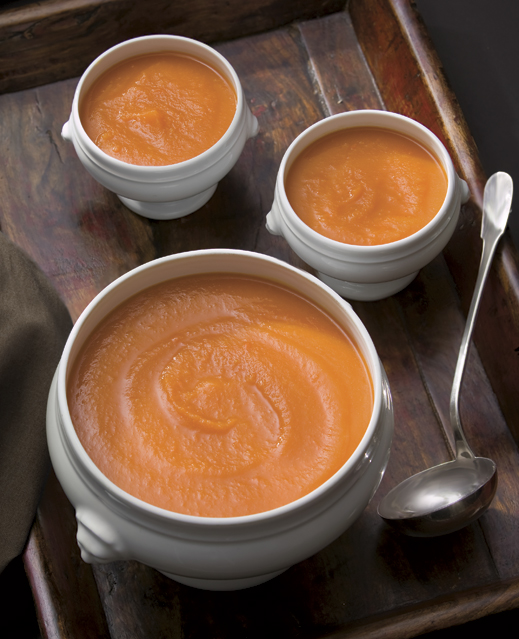
Soup puts the heart at ease, calms down the violence of hunger,
eliminates the tension of the day, and awakens and refines the appetite."
~Auguste Escoffier
The building was impossibly narrow, 10 feet wide at most. It stood on the corner of a short London street and looked as though someone had shaved three-quarters of the structure leaving only the decorated façade behind. All four floors housed a single restaurant. 40 seats tops. Just a few tables on each floor accessed by an impossibly narrow winding staircase that both tray carrying waiters and patrons nervously navigated. I preferred sitting at the bar on the ground floor. It felt very grown-up. I think I was 13 the first time I had lunch there with my father. He took me there to eat soup. We ate lobster bisque. It was heavenly. The epitome of sophistication in a bowl.
I have been thinking about soup a lot over the past few weeks as I’ve been writing this article and I realized that particular soups have played a starring role in many of the cities I called home over the past four decades. In each case linked to a restaurant where I would inevitably eat the same dish, that particular soup. One of my favorite haunts in Los Angeles had a sensational Soupe de Poisson complete with a rustic rouille and garlicky toasts to float on the surface and soak up all the fragrant juices; another in Golfe-Juan served a bouillabaisse that many drove across the country for; I remember a particularly chunky-creamy-yet-not-too-rich clam chowder in Newport, R.I. shared at communal tables in a casual deli, and an earthy mushroom soup in a tiny Paris Bistro which I would happily travel half-way around the world to get another taste of.
So what is it about soup that is so appealing? Ask anyone about soup and what sensations it conjures up for them and a reoccurring theme runs through their answers. It reminds them of home, their grandmother, their mother, their youth, being nurtured and comforted, it’s easy to make, it has endless possibilities, it’s easy to eat, and it’s healthy. As one of the founders of Gourmet Magazine, Louis P. De Gouy wrote in his ‘The Soup Book’ (1949) “Good soup is one of the prime ingredients of good living. For soup can do more to lift the spirits and stimulate the appetite than any other one dish.” No wonder that the age old remedy for a bad cold is a bowl of chicken soup!
I am no exception to the rule. I grew up eating soup almost every day as my mother had. Fresh vegetable soup, served pureed or in a clear broth. My grandmother made a wonderful vegetable ‘potage’, a creamy concoction with seasonal vegetables, leeks, shallots, potatoes and a few fresh herbs. She’d a dollop of crème fraiche in there sometimes for good measure. It was the perfect food after a day out in the snow. I liked dipping a piece of baguette in the soup so that it would soak it up which is perhaps just how soup got its name, as the word comes from ‘suppa’ and ‘sop’ which both mean "bread soaked in broth". Isn’t that one of the best parts of eating a bowl of hearty soup?
There are few dishes that can nourish one as completely as soup does. This was the very comment that Anthony Carroccio (founder and President of the Organic Soup Kitchen) made when I spoke to him about why so much of the food they prepare is centered around a hearty bowl of soup. I agree completely – it is a dish that sustains you.
Everyone I have spoken to is nostalgic about this dish. It’s evocative in a manner that is quite personal to each person. Perhaps that’s why, when I unexpectedly found myself around the corner from that very narrow restaurant, on that short London street last year, I immediately rushed over to taste ‘that’ bowl of soup….. I stood aghast in front of the scaffolding that encased the building, the new building. The old one had been demolished, the restaurant, and a 130 plus years of culinary history with it, all in the name of progress. What a shame! However, the memory of that soup lingers with me, perhaps that makes it all the sweeter.
CARROT, ORANGE AND GINGER SOUP
Carrots and oranges are marvelous together. Quite apart from the same vibrant color, the sweetness and zest of orange juice marries so well with carrots, enhancing their flavor. This soup has verve and the ginger adds a little spiciness to it.
Serves 8 people
2 ½ lbs carrots – peeled and chopped into 1 inch pieces
1 inch piece of fresh ginger – peeled and diced
Zest and juice of 2 oranges
2 tablespoons olive oil
4 cups fresh vegetable stock
Salt and pepper
1 tablespoon butter
2 tablespoons cilantro - chopped
ROASTED PARSNIP SOUP WITH A SAUTÉ OF WILD MUSHROOMS
Serves 8-10 people
2 large onions – peeled and diced
2 lbs parsnips – peeled and cut into 1 inch pieces
4 shallots – peeled and roughly diced
¼ cup olive oil
1 tablespoon cumin
8 cups vegetable stock
Salt and pepper
1 tablespoon butter
8 oz chanterelles (or other wild mushrooms–Shitakes work well) – cleaned and thinly sliced
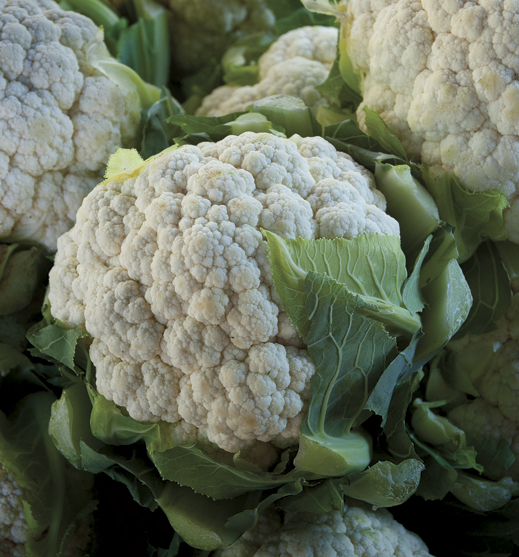
CAULIFLOWER SOUP WITH STILTON AND CARAMELIZED PEAR CHUTNEY
This recipe was inspired by Skye Gyngell and a Gorgonzola version she has in her book ‘A Year in my Kitchen’. I love the mixture of cauliflower with blue cheese and the added pop of the pear chutney creates a tasty juxtaposition between salty and sweet.
Serves 8 people
Olive oil
1 tablespoon butter
2 medium-sized onions – peeled and finely chopped
4 shallots – peeled and finely chopped
4-6 sprigs thyme
2 cauliflowers – leaves trimmed away and florets separated
1 bay leaf
8 cups vegetable or chicken stock
6 oz stilton.
Salt and pepper
4 tablespoons crème fraiche
For the pear chutney:
2 tablespoons butter
1/3 cup dried golden raisins/ cranberries
1 pinch saffron
3 pears – cored, peeled and chopped
¼ cup apple cider
2 tablespoons sugar
3 sprigs lemon thyme
Zest of 1 lemon
1 cinnamon stick
Coarse sea salt
Black pepper
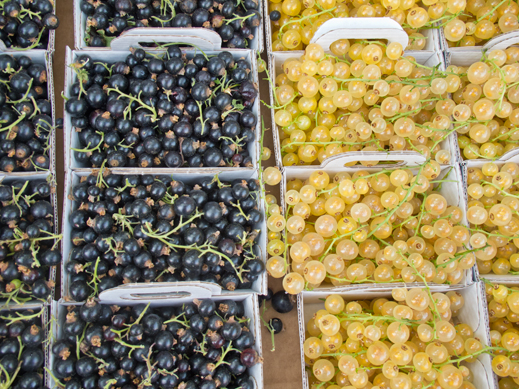
Cooking with Fresh Vegetable and Fruit Juices
Every day during the summer holidays we’d go to the same café in the harbor of the little fishing village near our farmhouse for breakfast. It had red tables, red chairs, red awnings and a magnificent zinc bar that stretched across the back wall of this well-known establishment. We’d always come in early and sit at the same table. It was a well-honed routine and we delighted in the camaraderie of the place. As we waited for the buttery croissants and toasted pain de mie to arrive we’d watch the mountain of fresh oranges that sat in crates on the bar being pressed – one by one – in a large chrome machine. The air would always be filled with a sweet tang of orange zest. The juice, served in tall narrow glasses, was pure, sweet and satisfying.
Over the years I have tasted different dishes in different countries that have captured the very essence of that ingredient just as that orange juice did: a cassis sorbet that sang of slightly tart, freshly-picked black currents, a gazpacho that fêted the tomatoes it was made from, an ethereal fava bean soup that felt as though you were drinking in a spring garden. I realized that this common thread – to be able to savor the main ingredient was nectar indeed. The common theme it seemed was the juice from which these magical dishes were made.
So I began to experiment. At first these were mostly fruit based concoctions. Purees of berries to be added to ice cream or as an accompaniment to a fruit tart for example. Some were weird. Many missed the mark; either too bland, too sweet or too tart. This is how the mango soup came about. I had made a smoothie with mangoes and oranges and liked the flavor combination but the balance was not quite right and a little acidic. At the next farmers market I found some incredibly sweet and juicy navel oranges. My taste buds pricked at the memory of those breakfast glasses of orange juice. Here was the answer to my smoothie. When I tried the blend that afternoon the chemistry between the two worked. I had used more orange juice than before and the mixture was more soup than smoothie so that’s how I tried it: in a bowl, with a spoon, with some freshly picked berries. As the days grew warmer it became my favorite dessert of that summer and those since.
During the past year I have been juicing and making purees of everything in sight. It all started with the juice left in the bottom of a plate of heirloom tomatoes that had been drizzled with olive oil. It was so tasty you just had to mop it up with a chunk of bread. This led to making vibrant vinaigrettes with mashed up tomatoes and then to great mounds of herbs being turned into bright green elixirs that transformed everything it was poured into from a plate of pasta to mashed potatoes.
Up to this point I had been pulverizing everything in my food processor or blender. Everything changed after I borrowed a juicer from a good friend of mine. I may have juiced every vegetable in the house. There are some I probably shouldn’t have – I thought leeks might be interesting addition to a green drink; they weren’t, yet worked well in a poaching broth for fish. I drank juice morning, noon and night and felt energized. My favorite way to start the day is now a glass of apple-carrot-lemon-ginger juice.
One day I juiced beets. I can honestly say that I loathed beets as a child. They were served boiled to death in the school canteen. They were slimy and slightly pickled. We’d try to hide them so we didn’t have to ingest them. It wasn’t until I came to California and tried roasted beets that I became slightly infatuated with this vegetable. The juice is rich in flavor (it’s also packed with antioxidants and nitrates that are good for you) and their intense color - from golden hues to deep plum - adds a beautiful touch to your culinary palate.
To those first cups of beet juice I added fresh orange and carrot juice and concentrated the mixture in a saucepan. The resulting sauce was a revelation to me. It was silky and gorgeous. Here was the essence of those vegetables in liquid form. Golden beets, yellow carrots and orange juice produced a sauce the color of Van Gogh’s Sunflowers. Dark red carrots and purple beets created something akin to a ripe fig. The fun part was (and is) pairing these combinations with different foods. Grilled or roasted duck and salmon both worked well, creating a salty-sweet, opulent yet clean mélange. These experiments are fun and vibrant.
Perhaps I’ll try making an orange-beet sorbet next: homage to that cassis sorbet and that orange juice.
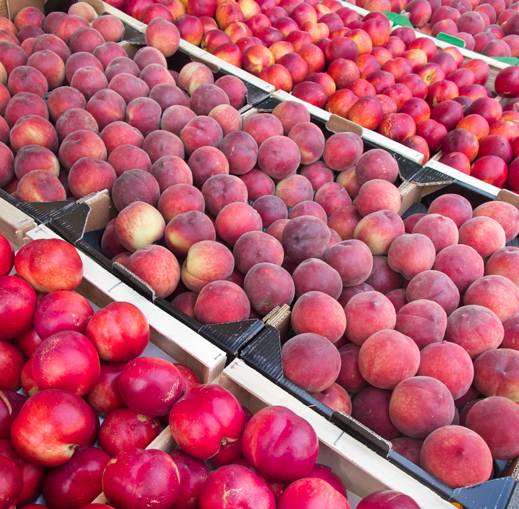
GRILLED PEACH, ARUGULA AND PROSCIUTTO SALAD WITH A TOMATO VINAIGRETTE
Serves 8 people
For the vinaigrette:
2 tablespoons olive oil
1 tablespoon vinegar
2 ripe heirloom tomatoes – stems removed and cut into quarters
Juice and zest of 1 lemon
Juice and zest of 1 lime
Salt and pepper
For the Salad:
4 large or 6-8 small firm-ripe peaches – cut into sixths
1 bunch basil – leaves left intact (if you can, try to find different varieties of basil)
1 bunch chives – finely chopped
8 oz arugula
8 slices prosciutto – pulled apart into small shreds
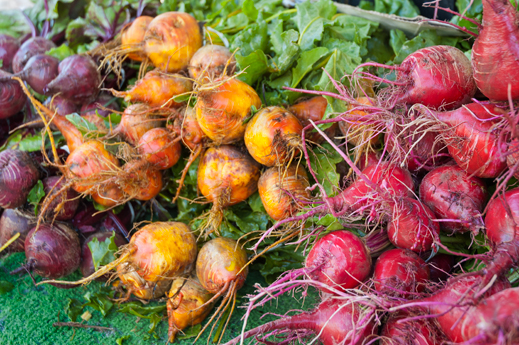
ROASTED GLAZED WILD SALMON WITH A BEET-CARROT JUICE SAUCE
ON A BED OF WILTED GREENS
Serves 8 people
For the salmon:
2 ½ lbs wild salmon filet – score the salmon into 8 equal parts but do not cut all the way through
1/3 cup honey
1 inch piece fresh ginger – peeled and finely chopped
Zest of 1 orange and 1 tablespoon orange juice
1 tablespoon Herbes de Poisson
For the wilted greens:
Olive oil
2 shallots – peeled and sliced
1/2 lb spinach
1 bunch either bok choy or Asian greens or broccolini – finely sliced
Lemon juice
Salt and pepper
For the beet-carrot juice sauce:
1 cup carrot juice
½ cup beet juice
1 cup orange juice
¼ cup sugar or 2 tablespoons honey
Pinch pepper
½ teaspoon coriander seeds
To assemble:
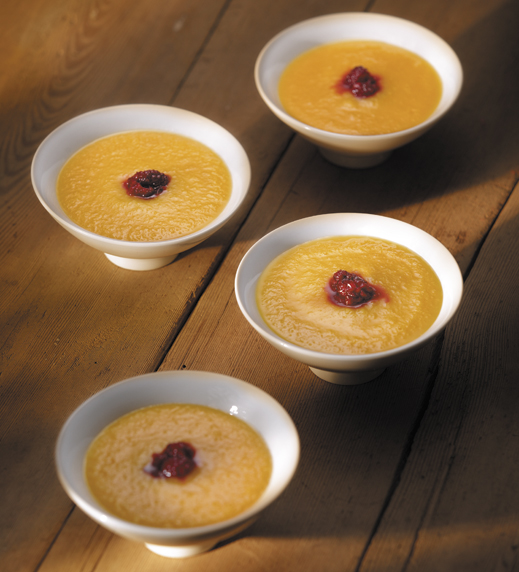
CHILLED MANGO-ORANGE ‘SOUP’ WITH CRYSTALIZED GINGER RASPBERRIES
From Pascale Beale’s A Menu for all Seasons – Spring (1st Edition)
Serves 8 people – This will make enough for a small bowl per person
3 ripe mangoes – peeled and the flesh cut into pieces
Juice of 6- 8 navel oranges
2 oz butter (1/ 2 stick)
1 1/ 4 oz brown sugar (3 tablespoons)
1 tablespoon freshly grated ginger
2 oz chopped crystallized ginger (4 tablespoons)
Zest and juice of 1 1/ 2 lemons
2 baskets raspberries
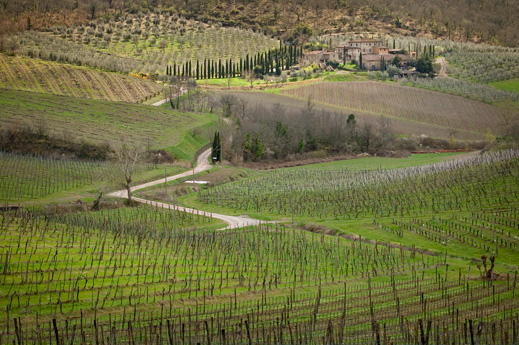
The house was nondescript. It stood squashed between its neighbors on a narrow street in a small, unpretentious village in a very remote part of the French countryside. I wondered why we were stopping here but was assured by our host, and my father, that this was a requisite stop of the utmost importance.
We were ushered into the salon – a slightly stale room at the front of the house. The owner’s wife stood by during the introductions but was dismissed by her husband with a wave of his hand which I thought rude. As soon as she was gone he suddenly got down on his knees and rolled back the worn carpet that covered most of the wooden floorboards. He reached for a latch in the floor and opened up a huge trap door. “I’ll be right back” he muttered and disappeared down an ancient ladder into the bowels of the house. Minutes passed. We heard the odd thud. He reappeared with cobwebs attached to his beret (yes he was wearing one) cradling a very dusty bottle which he reverently placed on a sideboard. He closed the trap door, rolled back the carpet, and summoned his wife to bring the glasses only to dismiss her once again.
Looks of anticipation were exchanged by the three men. The bottle was opened with great care, held up to the light and then poured into the waiting glasses. It looked like liquid gold. Its hue was the color of rich honey. It shone in the filtered sunlight. The man raised his glass and made a toast. My father tasted the wine and smiled knowingly. He looked at me and said, “Taste this – a sip – you’ll remember this for the rest of your life”. I took the glass and sipped the wine. This extraordinary, rich liquid startled me, as though it was filled with roasted fruit and flowers. It was a very rare sauternes. I was nine years old.
The owner’s wife bought in a fine duck liver pâté which was served on plain toast as an accompaniment to the wine. The combination of the two was the perfect. Suddenly all the conversations I had heard about food and wine made sense. When paired together well they were wonderful.
I realize now that wine played a central part in many of the dishes and desserts we grew up with. Coq au vin, Boeuf Bourguignon, Boeuf en Daube, French Onion soup, Baba au Rhum, Bananes Flambé and Crepe Suzette to name a few. A few years into my cooking in earnest I started using wine to deglaze pans in which roasts had been cooked as I had seen my mother and grandmother do. This was a simple way to get a good sauce out of all those tasty brown bits that were in the bottom of the pan. I learned (the hard way) that using the right amount of wine and letting it cook out the alcohol were crucial to having a good sauce. Too much wine and it drowned the flavors and not cooking it enough left an unpleasant taste and bitterness in the dish. After drowning a few fish and overpowering a couple of roasted chickens I finally got the hang of it and picked up some useful tips about cooking with wine along the way.
One of the most important was not to use cheap wine (aka a wine you wouldn’t think of drinking) in a sauce or dish. It will taste like cheap wine. That being said, nor do you need some ruinously expensive wine to make your dish successful. Cooking with wine enhances and compliments the food it’s cooked with whether you’re using it in a marinade (the acidic nature of wine and the tannins will tenderize tough cuts of meat), as part of a cooking liquid (as the wine evaporates its flavor will be concentrated and compliment the ingredients) or to flavor a finished dish (often a dessert that is set alight or has a fortified wine that soaks into it such as a Baba au Rhum).
The alcohol in the wine is not what imparts flavor, rather that it helps release flavors in the food you’re cooking (extracts such as vanilla and almond use alcohol for that very reason). Because of this using the right wine for the right dish is important. White meats such as poultry and fish are enhanced by lighter reds or white wines, red meats are complemented by more robust red wines. Vegetables are wonderful braised with white wine such as a sauvignon blanc and mushrooms can be magnificent served with a reduction made from port or a fruity red. Pears, citrus fruit and vanilla pair well with dessert wines and reds compliment berries, oranges and chocolate.
Cooking with wine is not a new phenomenon. Ancient Roman texts are filled with recipes that used wines to enhance their dishes. Reductions and braises abounded in Medieval kitchens and fortified or spiced wines have even been used as rations for troops in multiple wars. The key in all the dishes is using a judicious hand to extract the wines essence.
Last spring I came across a particularly fragrant crop of apricots at the farmers market and got slightly carried away. After making an apricot tart, some jam and roasting Cornish hens with them there were still a few left. I had some late harvest Riesling at home and poached the fruit with some spices. I spooned the fruit and accompanying liquid into a small glass bowl. Something about the color looked familiar. As soon as I took the first bite I was transported back to that village in France. The apricots had an echo of that sauternes. I savored every morsel with a film running through my mind of all the dishes created with this wine that I had been fortunate to taste over the years. My father was right – I had never forgotten that wine.
Other useful tips for cooking with wine:
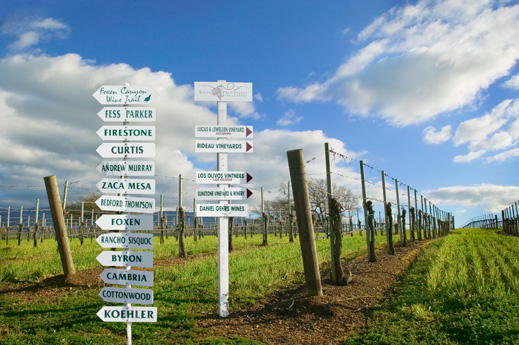
SPRING SALAD WITH GOAT CHEESE CROSTINI AND A RED WINE – BALSAMIC VINAIGRETTE
Serves 8 people
For the vinaigrette:
1/3 cup red wine (such as a merlot or zinfandel)
1/3 balsamic vinegar
2 tablespoons golden raisins
3 tablespoon olive oil
Pinch salt
Pepper
For the salad and crostini:
6 oz mixed salad greens – try to add some leaves that are a little peppery (such as arugula, dandelion or watercress)
16 small thin slices baguette or olive bread – toasted
Goat cheese
Golden raisins (from the recipe above)
Red wine-balsamic vinegar reduction (from the recipe above)
‘POACHED’ ROASTED WHITE FISH WITH MEYER LEMONS AND WHITE WINE
Serves 6-8 people
Olive oil
3 shallots – peeled and diced
4 green onions – very thinly sliced
2 cups white wine (such as a sauvignon blanc)
2 tablespoons chives – finely chopped
1 tablespoon dill – finely chopped
1 tablespoon butter
Pinch salt
Black pepper
Juice of 1 lemon
2 lbs white fish (halibut or sea bass work well) – the filets cut into ¼”-thick slices – you are creating petals of fish
3 Meyer lemons – very thinly sliced
POACHED APRICOTS IN LATE HARVEST RIESLING
Serves 8 people
2 tablespoons butter
1 tablespoon light brown sugar
3 cardamom pods – slightly crushed
Zest of 1 lemon
16-24 apricots – halved (if they are large then use 2 per person)
2 cups late harvest Riesling (or other dessert wine)
1 tablespoon honey